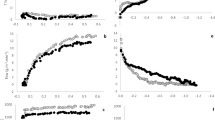Abstract
The initial responses to cold-water immersion, evoked by stimulation of peripheral cold receptors, include tachycardia, a reflex inspiratory gasp and uncontrollable hyperventilation. When immersed naked, the maximum responses are initiated in water at 10°C, with smaller responses being observed following immersion in water at 15°C. Habituation of the initial responses can be achieved following repeated immersions, but the specificity of this response with regard to water temperature is not known. Thirteen healthy male volunteers were divided into a control (C) group (n = 5) and a habituation (H) group (n = 8). Each subject undertook two 3-min head-out immersions in water at 10°C wearing swimming trunks. These immersions took place at a corresponding time of day with 4 days separating the two immersions. In the intervening period the C group were not exposed to cold water, while the H group undertook another six, 3-min, head-out immersions in water at 15°C. Respiratory rate (f R), inspiratory minute volume (V˙ I) and heart rate (f H) were measured continuously throughout each immersion. Following repeated immersions in water at 15°C, the f R, V˙ I and f H responses of the H group over the first 30 s of immersion were reduced (P < 0.01) from 33.3 breaths · min−1, 50.5 l · min−1 and 114 beats · min−1 respectively, to 19.8 breaths · min−1, 26.4 l · min−1 and 98 beats · min−1, respectively. In water at 10°C these responses were reduced (P < 0.01) from 47.3 breaths · min−1, 67.6 l · min−1 and 128 beats · min−1 to 24.0 breaths · min−1, 29.5 l · min−1 and 109 beats · min−1, respectively over a corresponding period of immersion. Similar reductions were observed during the last 2.5 min of immersions. The initial responses of the C group were unchanged. It is concluded that habituation of the cold shock response can be achieved by immersion in warmer water than that for which protection is required. This suggests that repeated submaximal stimulation of the cutaneous cold receptors is sufficient to attenuate the responses to more maximal stimulation.
Similar content being viewed by others
Author information
Authors and Affiliations
Additional information
Accepted: 6 February 1998
Rights and permissions
About this article
Cite this article
Tipton, M., Golden, F., Higenbottam, C. et al. Temperature dependence of habituation of the initial responses to cold-water immersion. Eur J Appl Physiol 78, 253–257 (1998). https://doi.org/10.1007/s004210050416
Issue Date:
DOI: https://doi.org/10.1007/s004210050416




